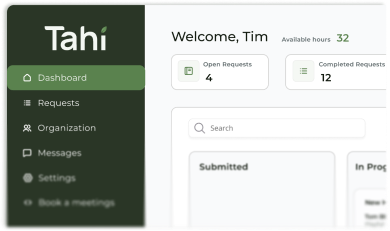Retainer Agreement
A retainer agreement is a long term contract where a client pays an agency a fixed fee each month to have their team and services available.
What exactly is a retainer agreement in a design agency context?
A retainer agreement is a long-term contract between a client and an agency. In essence, a client pays a fixed, recurring fee (usually monthly) to secure a block of an agency's time and resources. Think of it as having an agency 'on call' for your business. This model is common for ongoing needs like website maintenance, consistent content creation, or continuous marketing support, where the workload is relatively predictable over several months.
Unlike a one-off project with a defined start and end, a retainer is about establishing an ongoing relationship. The agreement typically outlines a minimum commitment period, often six or twelve months, ensuring the agency allocates dedicated resources to you. The goal is to provide budget predictability for the client and stable workflow for the agency, fostering a deeper partnership over time.
How are retainer hours and deliverables typically managed?
Management of a retainer agreement can vary, but it's usually centred around a block of pre-purchased hours. For example, a client might pay for 20 hours of Webflow development work per month. Any tasks, from small fixes to feature updates, are then deducted from this hourly balance. This requires diligent tracking and reporting from the agency to ensure transparency.
A common feature of many retainers is the 'use it or lose it' clause. If you only use 15 of your 20 purchased hours in a month, those remaining 5 hours often don't roll over. This can lead to inefficiency if your needs fluctuate. Furthermore, if work exceeds the allocated hours, it's typically billed at a separate, often higher, hourly rate. Clear communication and a well-defined scope are crucial to prevent misunderstandings and budget overruns.
What are the main benefits and drawbacks of a retainer model?
Retainers offer some clear advantages. The biggest benefit is having a dedicated team that is deeply familiar with your brand, goals, and platforms like Webflow or Figma. This long-term partnership can lead to more strategic and cohesive work. Budgeting also becomes more predictable, as you're paying a fixed fee each month, which simplifies financial planning.
However, the drawbacks are significant for modern, agile businesses. The primary issue is inflexibility. Being locked into a 6 or 12-month contract can be restrictive if your business priorities shift or if you experience a quiet period. The 'use it or lose it' nature of monthly hours can feel like you're paying for nothing during those slower times. This rigid structure can sometimes stifle the dynamic, iterative process that leads to the best digital products.
How does a retainer compare to a productised subscription service?
A retainer and a productised subscription might seem similar as they both involve recurring payments, but their core philosophies are quite different. A retainer is based on securing an agency's time. You pay for a block of hours, regardless of the specific output. The focus is on availability.
In contrast, a productised subscription, like our Webflow subscription model at Tahi Studio, is based on delivering outcomes. You pay a flat fee to have requests completed through a clear task queue, without worrying about counting hours. The focus is on the deliverable. This model offers far greater flexibility. You can pause or cancel your subscription at any time, ensuring you only pay for the service when you have active work. This is perfectly suited for iterative design in Figma and agile development in Webflow, as it adapts to your needs without the pressure of a long-term contract or wasted budget on unused hours.
How can I find a model that gives me quality without long-term commitment?
Finding a balance between expert quality and business agility is a common challenge. Traditional retainer agreements offer partnership but often at the cost of flexibility. This is precisely why we structured Tahi Studio around a productised subscription model. We believe businesses should have access to a senior-level, expert team without being locked into lengthy contracts.
Our approach provides the best of both worlds. You get the deep expertise and partnership feel of a dedicated team for your Webflow and design needs, but with the freedom to scale up, down, or pause as your business requires. All your requests, communications, and files are managed through our single client dashboard, removing the rigid constraints of a retainer. It's a modern partnership designed for growth and flexibility, not restriction.







